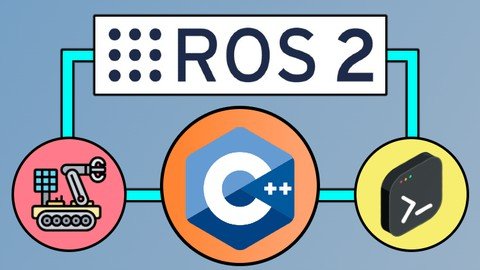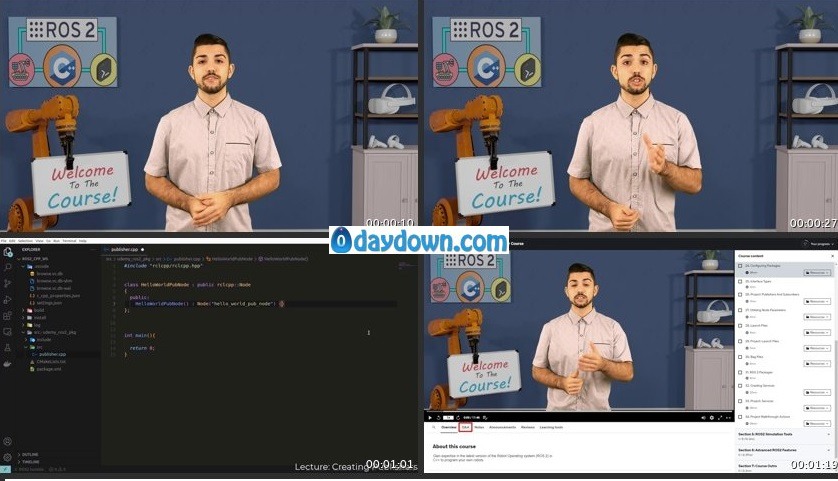
Published 11/2022
MP4 | Video: h264, 1280×720 | Audio: AAC, 44.1 KHz
Language: English | Size: 4.92 GB | Duration: 8h 1m
Gain expertise in the latest version of the Robot Operating System (ROS 2) in C++ to program your own robots
What you’ll learn
Learn about the tools available in the ROS2 Framework
Learn how to use the new ROS2 Client Library to develop code for robots in C++
Learn about Robotics Simulation Tools to create virtual Robotic environments
Learn how to utilize ROS2’s decentralized architecture to communicate between multiple robots
Requirements
General Computer Skills
Experience with C++ programming language
A computer capable of running ROS2 or a Virtual Machine
Some experience with Linux is recommended, but not required
Description
Learn how to use the Robot Operating System (ROS) version 2 platform (ROS2) which is used to program real world robotics. From Industrial Robots, to Autonomous Cars, to Research & Development systems; ROS is the back-bone of a wide variety of automated systems. The course is designed for beginners with little, to no experience using ROS2. The coding in this course is done in C++ using ROS2 Humble. We will go over installation of ROS2, how to develop code that uses the framework, and even go over simulation tools so you can make your own robot and control it in simulation, with code that can easily be ported to a real robotic system. This course is also well suited towards developers who utilized the previous ROS version, and want to learn how to use the newly reworked ROS2 API. It is also worth noting unlike ROS1, ROS2 has cross-platform support which allows it to be used on Ubuntu, Windows 10, and some versions of MacOS. ROS2 also allows for compatibility with ROS1 systems, so you can integrate your new ROS2 projects with your previous ROS1 systems. Course Outline:The course is broken into 7 main sections:Course IntroductionEnvironment SetupROS2 OverviewUsing ROS2 in C++Additional ROS2 ToolsRobotics SimulationAdvanced Features In ROS2Section 1 is a general introduction to the course.In section 2 you will learn how to setup your computer to be able to run ROS 2. This includes utilizing the Ubuntu operating system, installing ROS 2, and introducing you to the code editors we will be using in this course. In section 3 I will teach you at a high level what “tools” are included in the ROS 2 framework, and what each of them do.You will spend the majority of this course in section 4, learning how to implement all the various ROS2 tools in your very own C++ code. Section 5 will look at some tools which ROS2 provides outside of the coding environment. Section 6 will touch on using the simulation and sensor data visualization tools ROS 2 has to offer.Section 6 will go over advanced features of ROS 2. This will cover building ROS 2 from source in order to utilize tools such as SROS, which allows you to secure your topic data, as well as utilizing the ROS 2 bridge which lets you communicate with ROS 1 Nodes.We will also be working with the famous OpenCV library to work with image data coming from our robot’s camera. So what are you waiting for? Let’s get to programming, using the new and improved version of the most widely used open source robotics platform: ROS version 2.
Overview
Section 1: Course Introduction
Lecture 1 Welcome To The Course!
Lecture 2 What Is ROS?
Lecture 3 Things To Note About This Course
Section 2: Environment Setup
Lecture 4 Section Intro
Lecture 5[Windows] Install Virtual Operating System
Lecture 6[MacOS] Install Virtual Operating System
Lecture 7[Ubuntu] Installing ROS2 Humble
Lecture 8[Ubuntu] Installing Code Editor
Section 3: ROS2 Overview
Lecture 9 Section Intro
Lecture 10 ROS2 Framework Overview
Lecture 11 ROS2 Simulation & Visualization Tools Overview
Lecture 12 Changes Between ROS2 and ROS1
Section 4: Using ROS2 In C++
Lecture 13 Section Intro
Lecture 14 Asking Questions
Lecture 15 ROS Workspaces
Lecture 16 Creating Publishers
Lecture 17 Compiling ROS Nodes
Lecture 18 Debugging & Compiling In VS Code
Lecture 19 Creating Subscribers
Lecture 20 ROS Logging
Lecture 21 Interface Types
Lecture 22 Project: Publishers And Subscribers
Lecture 23 Node Parameters
Lecture 24 Launch Files
Lecture 25 Project: Launch Files
Lecture 26 Creating Services
Lecture 27 Project: Services
Lecture 28 Project Walkthrough: Actions
Section 5: Additional ROS2 Tools
Lecture 29 Section Intro
Lecture 30 ROS Index & ROS2 Packages
Lecture 31 Bag Files
Lecture 32 Visualization Tools
Section 6: Simulation – Ignition Gazebo
Lecture 33 Section Intro
Lecture 34 Ignition Gazebo Intro
Lecture 35 Using Sensors And Plugins In SDF
Lecture 36 Gazebo Classic Model Editor
Lecture 37 Simulation Launch Files
Lecture 38 Project: ROS2 Simulation Robot
Lecture 39 EXTRA: URDF Files
Lecture 40 Other Simulation Tools / Frameworks
Section 7: Advanced ROS2 Features
Lecture 41 Section Intro
Lecture 42 Local Network ROS Communications
Lecture 43 Security Configurations With SROS
Lecture 44 Building ROS2 Humble From Source
Lecture 45 ROS Bridge – Communicating With ROS1
Section 8: Course Outro
Lecture 46 Congratulations, Next Steps
Section 9: Bonus Section
Lecture 47 BONUS
Anyone who want to learn more about the newly developed ROS2 Framework For Robotics Software Development,ROS1 Developers who want to learn what new features are available in ROS2 and how to utilize it’s new API,Anyone who wants to learn how to program robots in C++
转载请注明:0daytown » Ros2 C++ Robotics Developer Course – Using Ros2 In C++
 Password/解压密码www.tbtos.com
Password/解压密码www.tbtos.com